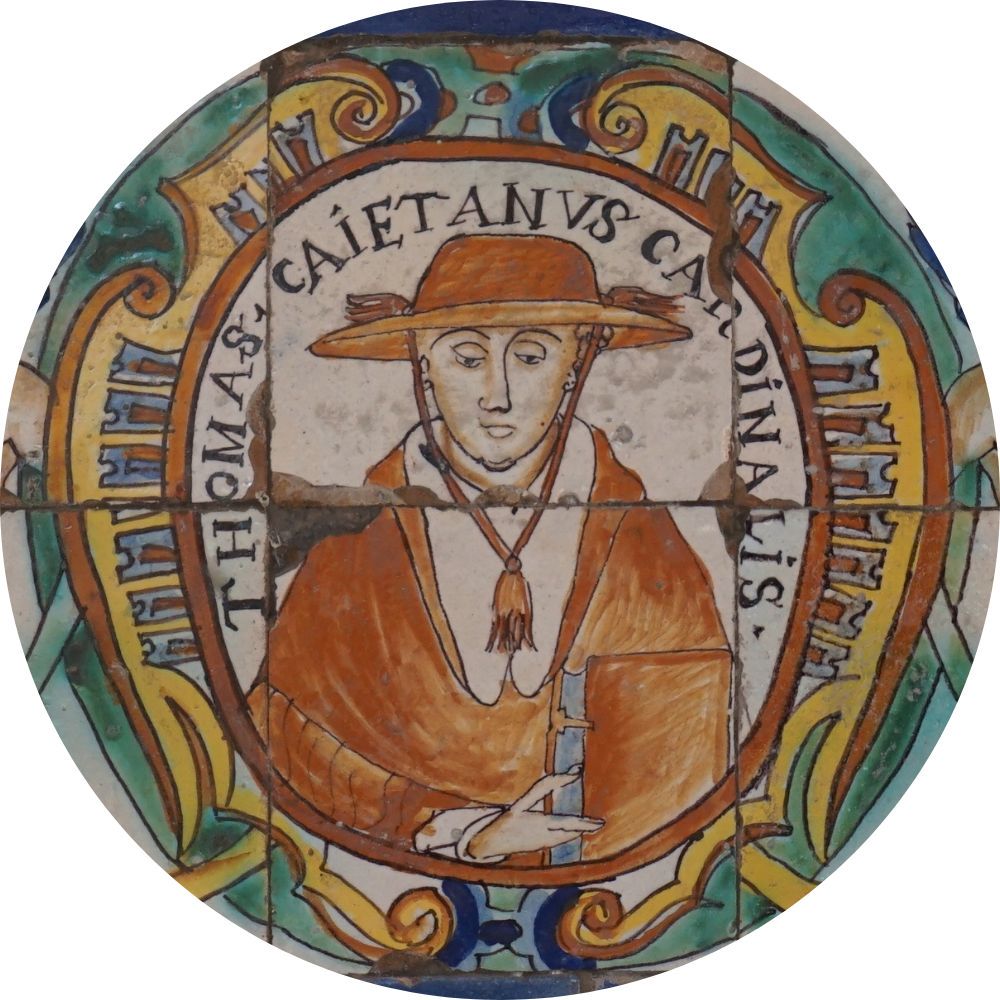Tom de Vio
Tom de Vio, cardinal
(1469-1534)
Giacomo de Vio was born on February 20, 1469, in Gaeta, Italy. He came from a noble family. Even in early childhood he was pious and liked to study. He entered the Dominican Order in his hometown in 1484 and took the monastic name Thomas (Tommaso). He took his philosophical and theological studies in Naples, Bologna and Padua. On March 19, 1492, he received a title of Lector of Sacred Theology. He was the master of the student brothers. He was a professor of theology at the universities of Padua and Rome. He began to attract students with his lectures and writings. His considerable scholarly fame came from a public debate with Pico della Mirandola (1463-1494) at the order's general chapter in Ferrara in 1494, which also earned him the title of Master of Sacred Theology. For the next few years, he lectured on the Summa of St. Thomas Aquinas in Brescia and Pavia. In 1501, he was appointed procurator general of the order, in addition to taking the chair of philosophy and exegesis at La Sapienza University.
In 1507, after the death of the Dominican master general, he became vicar general of the order, and a year later he was elected as the next general of the preaching order. He held the office for the following 10 years. At the time, he was also an advisor to the popes. In 1511, at the Council of Pisa, he became involved in the defense of papal rights, speaking out against Jacques Almain (1480-1515) of the University of Paris. As a result of his intervention, the works of this Parisian theology professor were burned by order of French King Louis XII. In 1517, Pope Leo X appointed him a cardinal, and in 1518 he became archbishop of Palermo, a year later he was appointed archbishop of Gaeta.
In 1518, Cardinal Thomas de Vio was sent to Germany in the role of papal legate to attend the election of Charles V of Habsburg as emperor of the Holy Roman Empire. While in Germany, he tried to stop the nascent Protestant Reformation and unsuccessfully urged Martin Luther to withdraw some of his theses and remain faithful to the teachings of the Catholic Church. In 1519, he returned to Rome and, at the will of the Pope, led the interrogation of Martin Luther.
The Pope, appreciating the cardinal's wisdom, entrusted him with the case of English King Henry VIII, who wanted to obtain from the Holy See an annulment of his marriage to Catherine of Aragon. On March 23, 1534, at a solemn consistory of Clement VII, Thomas de Vio announced his final verdict on the validity of the marriage, denying the English sovereign a divorce. This was the last public act in the life of this ecclesiastical dignitary, as he died the same year (August 10) and was buried, as he had requested, in a modest tomb in the vestibule of the church of Santa Maria sopra Minerva. In the popular opinion of his contemporaries, had he lived, he would have succeeded Clement VII on the papal throne.
Thomas de Vio, known as Cardinal Cajetan, was described as small in body but gigantic in intellect. In all his varied and industrious offices, he never neglected his daily studies and writing, nor did he fail in the practices of religious life. He calmly and fearlessly confronted the difficult problems of his time and attempted through science, tact and charity to calm hostile minds, draw away the erring, stem the tide of heresy and prevent schism. Pope Clement VII called him "the lamp of the Church"(Lucerna Ecclesiae).
In theology, Cajetan is rightly counted among the leading defenders and promoters of the Thomistic school. His greatest work is his commentaries on Aquinas' Summa Theologica, written between 1507 and 1522. In them, the Dominican and then cardinal defended the teachings of St. Thomas against attacks by Bl. John Duns Scotus (1266-1308). In the third part, he discussed the aberrations of the Reformers, especially Luther.
The portrait of Cajetan enjoys some great interest, the only known one, recently discovered by the Dominican Père Berthier in a collection of Reformation notables belonging to Count Krasinski of Warsaw.
In the Lima medallion, Cardinal Thomas Cajetan is depicted in cardinal's attire and holding a book in his hand, as a sign of the great number of works he left behind. As in the images of the other cardinals, here, too, there are angels on the sides, having attributes that belong to those who hold the cardinal dignity - a hat and a cross.
Bibliography:
- Limbourg M., Kardinal Kajetan, „Zeitschrift für katholische Theologie”, 4 (1880), issue 2, pp. 239-279.
- Cossio A., Il Cardinale Gaetano e la Riforma, Cividale 1902.
- Allaria G., Tommaso De Vio: cardinale Gaetano, Gaeta, La Poligrafica, 1969.
- Cajetan Responds A Reader in Reformation Controversy, ed. J. Wicksm Washington 1978.
- Wicks J., Cajetan und die Anfänge der Reformation, Münster 1983 (Katholisches Leben und Kirchenreform im Zeitalter der Glaubensspaltung, 43).
- Özen A., Luther und Cajetan in Augsburg 1518, Göttingen 1992.
- Izbicki Th. M., Cajetan’s Attack on Parallel’s Between Church and State, „Cristianesimo nella storia”, 29 (1999), pp. 81-89.
- Horst U., Juan de Torquemada und Thomas de Vio Cajetan. Zwei Protagonisten der päpstlichen Gewaltenfülle, Berlin 2012.
- Cajetan und Luther. Rekonstruktion einer Begegnung, hrsg. M. Siebeck, M. Basse, M. Nieden, Tübingen 2021 (Studies in the Late Middle Ages, Humanism and the Reformation, 124).

